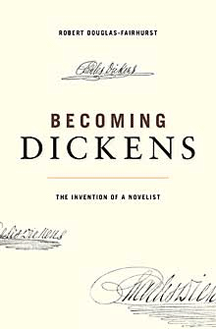By Carey Wall
London in the 1830s assumes a character in Douglas-Fairhurst’s Becoming Dickens second only to the young writer himself. It was a place in motion. The Reform Bill had passed, admitting more Britains and new industrial cities to suffrage; transition and uncertainty hold sway as the old balance shifts. The city itself is expanding rapidly, building out to what have been separate suburbs so swiftly as to horrify residents there. Lower middle class people are piling into London seeking jobs and advancement. Contextual research lies layers deep in all parts of the book, strengthening and lengthening it. Douglas-Fairhurst includes statistics, for instance, about how many young and old writers were in the city trying to make a living by the pen in comparison to how many pages in the newspapers and periodicals were available to be filled. Failures and tragedies were as exemplary as successes. It was “a hand-to-mouth literary scene.”
Douglas-Fairhurst argues, again and again, contexts and quotations building up the case, that even in his later years as well as in his youth, Dickens was haunted by the closeness of failure to success. Dickens eased into non-newspaper print with sketches of diverse London characters; “Yet if there is a strand of thought which links Dickens’s sketches together, it is the ease with which lives can be stymied or knocked off course.” “To some extent he was voicing much broader fears of the period, especially in London, where dreams of upward mobility were forever shadowed by fears of the opposite movement downwards.” Among his new sketches, “many . . . circled anxiously around the large differences there could be between lives separated by only a few inches, like the pedestrians who walk past the walls of Newgate Prison ‘with a light laugh or a merry whistle,’ oblivious to the fact that they are ‘within one yard of a fellow creature, bound and helpless . . . whose miserable career will shortly terminate in a violent and shameful death’.” Mirrored exchanges between characters “also recognize the vulnerability of social categories, and the ease with which “ they “can be transformed into each other.” Concerning the idea of home as comfort and safety, Dickens in Oliver Twist found it to be precarious:
“…at the same time that Dickens was attempting to create a settled domestic life on Doughty Street, he was busy terrifying himself with far nastier alternatives on the page: houses that are broken into . . . or houses that turn out to be the sort of traps from which there is no escape; characters like Nancy, whose reward for insisting that ‘I must go home” is to be bludgeoned to death….”
Speaking of the end of Oliver Twist, young Dickens’s new biographer says, “The final version of the story is now so well known, we tend to ignore how often it is crossed by false trails and studded with dead ends, but at its heart lay Dickens’s sense of how many different outcomes could be produced by the same set of events.” The plot of Bleak House asks “`What connection can there be?’ between people and places that at first appear wholly distinct, and eventually reveals that those at the top of the social world are as unavoidably connected to those at the bottom as a body and its shadow.”
Dickens’s fictional techniques and composite substance Douglas-Fairhurst sees as shaped by these social realities to which Dickens was so sensitive. He used “the democracy of comedy” to calm fears he had raised about “social unpredictability.” “The carefully judged disparity between weighty subject matter and airy tone is a technique he would develop throughout the 1830s, largely as a way of shocking his readers out of automatic responses to serious social problems.” “One way of summarizing his fiction would be to say that he attempted to show how many private worlds are contained in the public world we share—his writing is an unflagging celebration of the unique, the freakish, the stubbornly eccentric—while also reminding us of what we have in common.”
Douglas-Fairhurst’s writing is notably fluent and illuminated by engaging active verbs and similies: “Even putting them together only balances things out by playing different kinds of lopsidedness off against each other, like someone with a limp in both legs.”
Carey Wall (ΦBK, University of Michigan,1957) is a professor emerita of English and comparative literature at San Diego State University and a resident member of the Nu of California chapter of Phi Beta Kappa.




